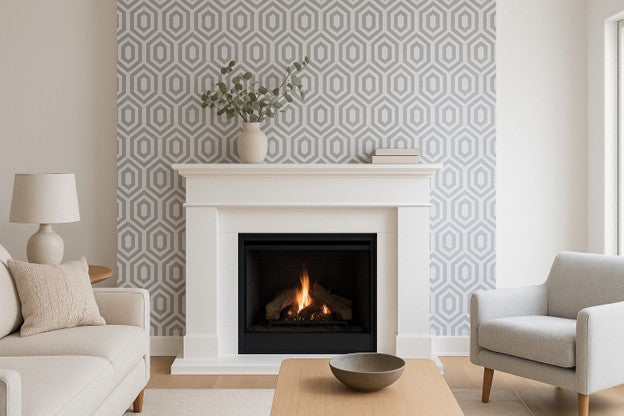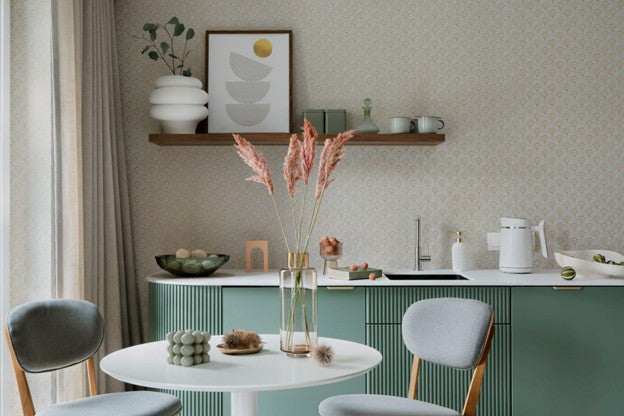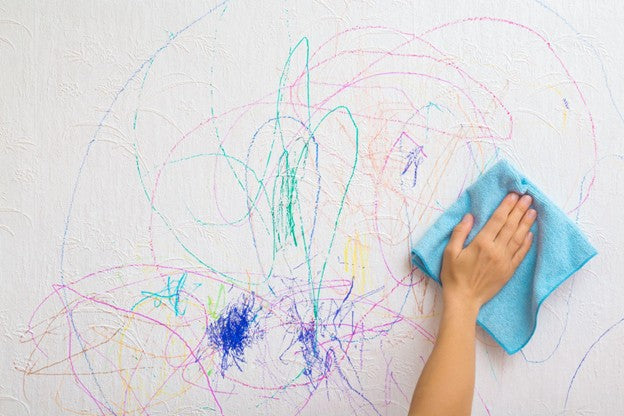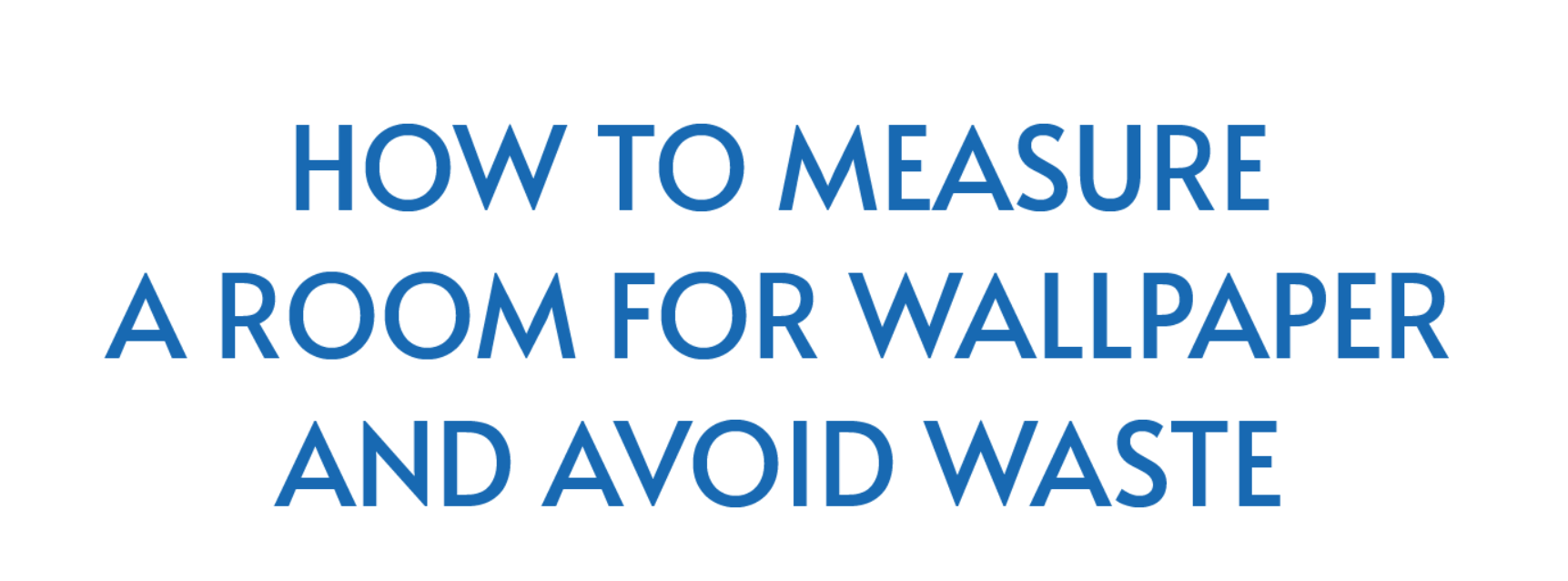A fireplace tends to be the natural focal point of a living room, and adding wallpaper around the space can make it even more striking. With the right tools, prep, and products, this project is achievable for most DIYers and can transform a plain wall into a dramatic statement in just a weekend.
Safety and Suitability
So can you put wallpaper around a fireplace safely? The answer is yes—with proper precautions. Fireplaces generate warmth that can cause nearby materials to expand and contract as the fire heats and the room cools. Over time, this movement can weaken seams if they’re not prepared correctly.
To help ensure long-lasting results, keep wallpaper off any surface that becomes hot to the touch and focus on the surround area above the mantel or on adjacent walls. When selecting wallpaper for fireplace surrounds, look for products rated flame-retardant or fire-resistant. These can provide an added layer of safety. Confirm your wallcovering meets local code requirements and carries a Class A fire rating where required.
Follow your local building code for fireplace clearances. Many jurisdictions require 6 inches or more between the firebox and combustible finishes like wallpaper.
It’s best to plan your project for a time when the fireplace won’t be in use. Installing wallpaper around a fireplace during cooler months ensures stable temperatures and a more comfortable working environment.
Choosing the Right Products

Success with fireplace wallpaper starts with the right products. As with most wallpaper installation projects, a primer provides a smooth, uniform base that promotes adhesion and makes future removal easier. ROMAN PRO-977 Ultra Prime® is a premium pigmented wallpaper primer that delivers excellent water resistance and creates a white background that allows bold patterns to pop.
For the adhesive, ROMAN PRO-880 Ultra® Clear is a versatile wallpaper adhesive that offers maximum wet-tack and extended open time. This combination of wallpaper primer and adhesive helps you achieve a strong bond while keeping seams crisp and clean.
Note that adhesives such as PRO-880 are not heat-resistant products—use wallpaper only on cool-to-the-touch areas outside the required clearance zone.
Tools and Materials You’ll Need
- Wallpaper rolls of your chosen design
- Wallpaper primer (such as PRO-977)
- Wallpaper adhesive (such as PRO-880)
- Level or laser for plumb lines
- Tape measure and pencil
- Smoothing brush or squeegee
- Seam roller
- Sharp utility blades with extra refills
- Metal straightedge
- Sponge and bucket of clean water
Having the right tools makes wallpaper installation more efficient and helps you achieve a professional finish.

Preparing the Fireplace Surround
Taking the time to get your surround ready ensures the wallpaper adhesive bonds well and that seams stay tight over time. Follow these steps before hanging wallpaper for fireplace walls:
- Clean thoroughly – Remove soot, dust, and grease from the surround area using a mild cleaner and a damp sponge.
- Repair imperfections – Patch nail holes or damaged drywall so the surface is smooth and sound.
- Check the surface – Make sure the wall is dry and free from peeling paint or old wallcovering.
- Prime the wall – Apply a high-quality wallpaper primer to enhance adhesion and support easier removal later. Allow primer to dry completely before moving forward.
Wallpaper adheres best to smooth, stable surfaces such as drywall or cured plaster. Both should be primed with a high-quality wallpaper primer like PRO-977. Masonry surfaces such as brick, stone, or concrete can be more challenging—an adhesion-promoting primer (like PRO-935 R-35) may help, but seams are harder to maintain on uneven textures. In high-heat areas, painting or decorative panels may be a better option than wallpaper.
With these prep steps complete, your surround is ready for wallpaper installation.
Plan the Layout for Maximum Impact
A fireplace is usually the centerpiece of a room, so planning your wallpaper carefully is essential. If you’ve chosen a bold pattern, map the design so it’s centered on the firebox or mantel. Mark a plumb line at the visual center of the surround and use it as your guide for the first strip. Building outward ensures the design looks balanced across both sides of the fireplace with wallpaper.
This planning stage also gives you time to think about how to wallpaper around a fireplace in a way that ties into the room’s design. For example, geometric prints can add modern flair, while botanical patterns create a softer backdrop. Considering a number of ideas before you start can inspire creative directions.
Cutting and Trimming Around Mantels
Fireplace mantels vary from simple shelves to ornate architectural statements. Decorative moldings often require multiple relief cuts to help the paper sit flush against the surface without tearing. Use a sharp blade and metal straightedge, and change blades often to keep cuts clean. Work slowly, trimming excess once the wallpaper is in place rather than pre-cutting too tightly. This ensures the wallpaper fits snugly along edges and profiles without gaps.

Hanging the Wallpaper
With the wall primed and your layout marked, it’s time for wallpaper installation. Apply your wallpaper adhesive evenly with a roller or pasting machine. If your wallpaper is not pre-pasted, coat the back thoroughly, fold the strip (a technique known as “booking”), and let it relax briefly. Starting at the center plumb line, hang the first strip, smoothing outward with a brush or squeegee to remove bubbles. Take care not to stretch the paper, which can cause seams to shift later.
Continue hanging strips outward from the center, carefully aligning the pattern. Around the firebox opening, allow wallpaper to overlap slightly, then trim it in place with a straightedge for precision.
Dealing With Heat-Adjacent Zones
When working with wallpaper for fireplace areas, avoid covering surfaces that warm significantly during use. Instead, let trim, tile, or stone serve as a protective border. Press seams firmly and use a seam roller lightly to set edges without forcing out adhesive. Placing seams away from the hottest areas will help them last longer.
Finishing Touches and Aftercare

If you notice small bubbles after the wallpaper dries, pierce them with a pin or make a tiny slit to release the air, then smooth the area flat. For stubborn issues or complex mantels, it may be worth consulting a professional installer.
Over time, watch for lifting seams, bubbling, or discoloration—early signs that heat may be stressing the wallcovering.
With the right prep and installation products, your fireplace wallpaper project will be complete in no time—and the results will keep drawing eyes season after season.
Recent Posts
-
How to Use Wallpaper to Create a Faux Brick Effect
read more >> -
Wallpapering Inside Closets & Pantries: A Fun Surprise Element
read more >> -
How to Install Wallpaper on a Fireplace Surround for a Bold Touch
read more >> -
How to Wallpaper a Kitchen Backsplash (and Waterproof It)
read more >> -
How to Remove Stains From Wallpaper Without Ruining It
read more >> -
How to Measure a Room for Wallpaper and Avoid Waste
read more >>







